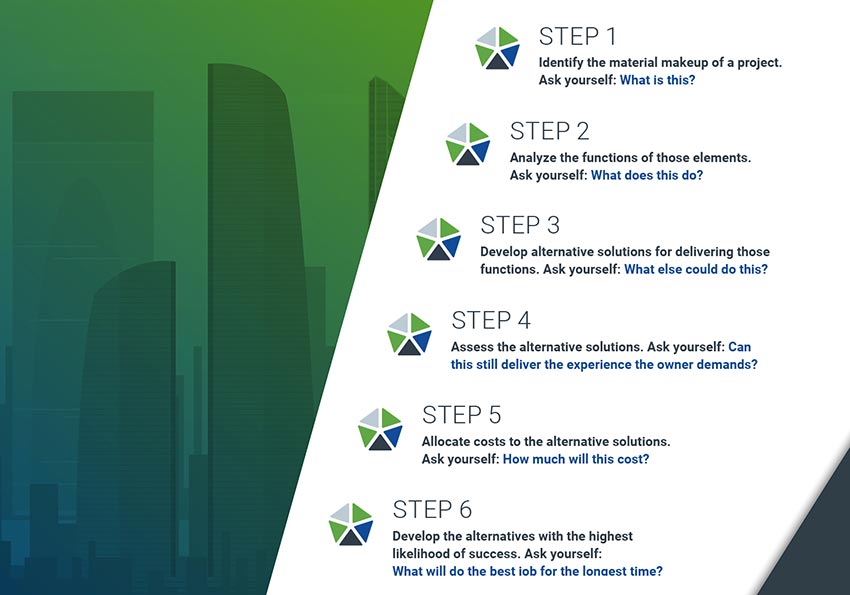Design Driven by Accurate Cost Data
This approach has been applied to building design and construction in a number of ways. When it used openly and continuously during design, it can allow for multiple iterations of potential material and assembly solutions to be evaluated and assessed. In this case, it is a means of seeking the best value for the building owner while still meeting all of the design and performance requirements identified by the design team. It has sometimes been used improperly too, simply as a mantra to cut costs without regard for the desirable or needed aspects of the project that certain materials and systems contribute. Hence, before it is undertaken, it must be clearly understood by all stakeholders.

Value engineering is based on an orderly, objective process that follows six distinct steps to be effective.
Undertaking value engineering commonly includes a six-step process that is intended to be truly objective. These steps can be summarized as follows:
- What is this? The focus of the value-engineering effort is to identify the specific materials, components, assemblies, and systems that make up a project. Then it requires taking a focused look at the selected items being scrutinized in the project and clearly identifying each of them.
- What does this do? Each identified item then needs to be looked at in terms of function. If it contributes to a design function, that needs to be articulated. If it contributes to the short- or long-term performance of the building, the level of performance and a description of how it does that should be defined. If it does both to one degree or another, its multifunctionality should be clearly understood. The analysis of the specified or selected item is important for the next steps so this should be done with reasonable thoroughness.
- What else could do this? This is the point where alternatives are identified. Using the item description and functionality as a basis, a review of other available options is undertaken. At this point, all potential choices should just be objectively identified regardless of cost.
- Can this still deliver the experience the owner demands? Each identified alternative now needs to be assessed. Can it really do the same things that the original item can? Does it provide the same or acceptably similar design characteristics? Can it be shown to perform as well or better than the original item? This step may involve a side-by-side comparison of the specifications for each, or an in-situ review of how they both look and fit within the rest of the design. Either way, a fair and honest comparison is needed to determine which ones are acceptable and which ones are not.
- How much will this cost? Now to the crux of the matter: What is the difference in cost between the original and acceptable alternative item(s)? This is where the full power of cost estimating is needed not only to be sure that material or product costs are accurate between the two but also that labor or other costs are fairly represented for each. For example, it makes little sense to save a small amount on a product if it is going to require twice as much labor to install it. Therefore, all aspects of a unit cost for each proposed alternative need to be accounted for. Once the two items are fairly and consistently estimated in terms of cost, they can then be compared so that an assessment can be made as to whether it is worth making the substitution or staying with the original design.
- What will do the best job for the longest time? Once each of the options are fully analyzed as described, it is time to make the value judgement. The choice should go to the option with the highest likelihood of success in a project that provides the owner with the greatest value. That means it was not eliminated from consideration because of not meeting design and performance criteria and it represents the best overall cost option. It also needs to have enough quality that it will not wear out quickly or cause other operational problems. Hence, this step is all about identifying the best product, at the best price, with the best operational record.
As should be clear by now, the key to a good value-engineering process is access to a good and reliable source of construction cost data. Third-party, independent cost data will provide the most objectivity and allow everyone involved to make accurate, informed decisions. In the end, it is all about identifying the best alternatives.









